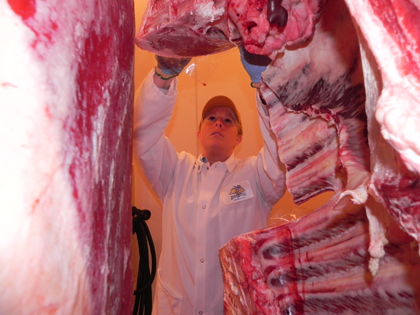Can changes to a cow's energy intake during the second trimester enhance the quality of beef her offspring will produce? What effect might it have on the reproductive ability of the cow's offspring? Those are questions a team of SDSU researchers are studying.
Known as fetal programming, this concept suggests that during development of the fetus important biological parameters can be manipulated and these alterations can carry through to maturity. While fetal programming has been studied in human health, it's a relatively new area of research in the beef industry, explains SDSU associate professor of animal science Amanda Blair.
With more than $411,000 in funding from the U.S. Department of Agriculture and the South Dakota Beef Industry Council, Blair and her colleagues began a four-year project in 2010 to determine how limiting a cow's energy intake during the second trimester affected her calf. Blair says, "We focus primarily on the second trimester because that's when the bulk of the muscle development [of the fetus] occurs."
She worked with SDSU Extension meat specialist Keith Underwood, feedlot nutritionist Robbie Pritchard, and geneticists Michael Gonda from SDSU and James Reecy, director of Iowa State University's Office of Biotechnology. Three doctoral students have also been involved in the project. Former SDSU Ruminant nutritionist Aimee Wertz-Lutz is involved with the project as well.
By better understanding fetal programming, the researchers hope to eventually enhance the quality and quantity of beef.
The team divided 151 cows at the Cottonwood Range and Livestock Field Station near Philip, S.D., into two groups. All cows were bred in June 2010 and the groups were managed the same until the second trimester. During that 90-day period, one group was fed a "positive" energy diet to maintain an average body condition score of five, meaning the cows maintained their weight or gained slightly. The second group was fed less energy - a "negative" energy diet - to lose body condition.
Protein was held constant, so the only variable was energy, Blair explains. In the third trimester, the cows were then given the same rations.
"We didn't want to be extreme," Blair explains. "We wanted to mimic what could normally happen in a production setting. Losing one-half to one body condition score during the winter is traditionally OK." Then producers usually increase the nutritional levels in the third trimester.
The calves were born in April and May 2011, weaned in October and brought to the SDSU feedlot. In spring of 2012, twenty-four head were harvested at the SDSU Meat Lab and analyzed for changes in gene expression. The remaining steers and heifers were processed at Tyson Foods in Dakota City, Neb., where carcass data and meat quality attributes were recorded.
Overall, the study showed that "altering maternal energy during mid-gestation impacts the fat deposition of the offspring," Blair explains. The calves from cows in the negative energy group had a more favorable distribution of carcass fat.
"They had an increase in marbling relative to back fat," Blair noted. "From a beef production standpoint, that's exciting."
But, she cautions, "We don't know what would happen long-term with the females." A University of Nebraska study suggests that these females will be negatively affected as breeding stock.
The yield grade of the offspring from the negative energy cows - who cost less to feed - also was improved, Blair says. This measure looks at carcass weight, back fat, percentage of kidney, pelvic and heart fat and ribeye area. Meat tenderness and color were unaffected by the maternal diets.
Though this looks good to cattle producers, Blair isn't ready to issue any recommendations. "We have a lot to learn," she says, particularly when it comes to breeding stock. She explains fat is very important to reproduction, both the age at which the animals reach puberty and their fertility.
Next, Blair and fellow SDSU researchers will investigate the effects of reducing protein intake during mid- and late-gestation. The project has received funding from the South Dakota Beef Industry Council, and will be done in collaboration with University of Nebraska reproductive physiologist Rick Funston.
"These types of studies allow us to look at the whole beef system from conception to consumption," Blair says. Only when researchers know more about the mechanisms and what's changing will they be able to advise producers on using fetal programming as a management tool.
This information was originally published in the SDSU Agricultural Experiment Station 2013 Annual Report.






